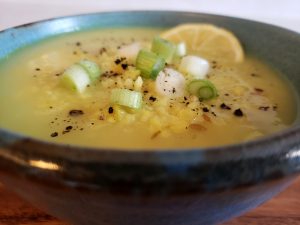 During times of sickness, some of the first symptoms to arise are a dull appetite, mild nausea, and lack of hunger. This is because the Agni or digestive fire is severely weakened due to the presence of excessive toxins, bacteria, or viruses that tend to overwhelm the system at these times. Whether you are experiencing a common cold, fever, or flu, eating the proper diet while sick is essential for healing the body, flushing away toxins (and bugs!), boosting the immune system, and strengthening digestion.
During times of sickness, some of the first symptoms to arise are a dull appetite, mild nausea, and lack of hunger. This is because the Agni or digestive fire is severely weakened due to the presence of excessive toxins, bacteria, or viruses that tend to overwhelm the system at these times. Whether you are experiencing a common cold, fever, or flu, eating the proper diet while sick is essential for healing the body, flushing away toxins (and bugs!), boosting the immune system, and strengthening digestion.
What is a proper diet during illness?
According to Ayurveda, one should eat solely warm, soupy, mushy, well-cooked, easy-to-digest meals anytime the digestive fire is weak or debilitated. The ingredients should be minimal, simple, and apart from some warming spices, fairly bland. With this in mind, this Get Well Kitchari recipe is a great option, as it follows all of these recommendations. It also has some nourishing ingredients to strengthen the system and some cleansing spices to flush out the GI tract.
When is the best time to eat Get Well Kitchari?
This recipe should be utilized for the entirety of the illness, ideally making up the main component of your diet. During more severe colds, fever, and flu, it can be eaten as a mono-diet (meaning no other foods are taken at this time) and served in as big or little of quantity that feel appropriate to your hunger signals. Remember that although some food is needed to keep up strength during the illness, you should avoid eating without hunger since this is a clear sign that the digestive fire is weak and needs a break. At these times, it will be best to take the kitchari in about 1 to 2 cup servings, 2 to 3 times throughout the day until the hunger begins to return.
Once the digestive fire feels more robust, you can slowly begin to add in vegetables and extra mung dal to make it a bit more tasty, hearty, and nutrient-dense. Other foods can then be added to the diet as well, although the main principles mentioned in paragraph two above should be kept until the healing period is over and optimal health has returned.
Although this is an essential recipe for times of illness, Get Well Kitchari can be very beneficial during kitchari cleanses, general detox programs, post-cleanses, pregnancy, postpartum, post-surgery, and throughout chemotherapy treatment, as these are all times that the Agni (digestive fire) is weak and debilitated.
What foods should be avoided during illness?
While making this recipe a staple meal during illness, it will be equally important to avoid all raw, cold, rough, heavy, sticky, dense, processed, and sugary foods. Some examples would be (but not limited to) meat (except meat broths), dairy, juice, smoothies, dry cereals, protein bars, milk, ice cream, cheese, store-bought yogurt, pasta, heavy grains, fatty foods, acidic food, and any food that contains added sugars (honey is alright in moderation).
Healing Benefits of Get Well Kitchari
Bone broth, chicken broth, or veggie broth:
By using one of these broths as a base, you are providing the body with easy-to-digest nutrients that are readily available for absorption. Ideally, a homemade broth should be used to receive the full healing benefits; however, if store-bought is necessary a sodium-free, organic brand is best. **Some grocery stores and restaurants are now providing some freshly made broth options!
Click here for our Healing Ayurvedic Bone Broth recipe.
Mung dal:
Mung dal is the split version of the mung bean and is used in any traditional kitchari recipe for its high nutrient content and easy-to-digest nature. This recipe utilizes an exaggerated amount of liquid making the mung dal even more digestible and easy on the stomach. If mung dal is not available, you can replace this with an equal amount of split red lentils.
Basmati rice:
Basmati rice is a kitchari essential due to its soft nature and easy-to-digest properties. Eating Basmati rice along with the mung dal creates a “perfect protein” meaning it provides all of the 9 essential amino acids. If basmati rice is not preferred, you can replace this with an equal amount of white quinoa.
Fresh lemon juice:
Fresh lemon juice is used to add a touch of immune-boosting vitamin C while simultaneously flushing toxins and providing you with essential digestive enzymes.
Fresh ginger:
Fresh ginger is unparalleled in its ability to heal during times of illness. Some of its major health benefits include boosting digestion and immunity, detoxifying the system, relieving nausea, promoting sweating, and alleviating fever.
Spices (black pepper, turmeric, cumin, fennel, brown mustard seed):
These spices have been carefully chosen as they all are well known for their digestive-enhancing properties. Utilizing these spices during illness will aid in flushing the system, killing off unwanted bacteria and viruses, promoting sweating, and reducing fever.
Ghee:
Ghee is another kitchari essential as it is known to boost the digestive fire, promote healthy elimination, and increase our vital immunity and energy (Ojas).
Garlic:
When used properly, this heating vegetable is very effective at stimulating the digestive fire and detoxifying the system. Garlic is a potent immune-boosting, antimicrobial agent and is very beneficial for the system during illness (in moderation).
Green onion:
Green onion has been added to help spark digestion, add a bit of flavor, and provide you with some much-needed vitamins (i.e. A, C, K). Studies have shown this tasty condiment enhances immune function, making it even more of an essential ingredient for our Get Well Kitchari!
Purchase all of your Kitchari essentials here!
Get Well Kitchari Recipe
Click here for a printable copy of this recipe.
- Doshic effect: Vata ↓, Pitta ↑*, Kapha ↓
- Serving: 5 to 6 cups (this recipe can be doubled if needed)
- Prep Time: 45 minutes
- Cook Time:
- Gluten-free, Vegetarian (can be made vegan)
*This recipe is overall heating, however, during times of illness, Pitta types can still benefit as the heat helps to kill off microbes, promote sweating, alleviate fever, and detoxify the system.
Materials
- Medium-large saucepan
- Measuring spoons and cups
- Cutting board and knife
- Ginger grater (optional)
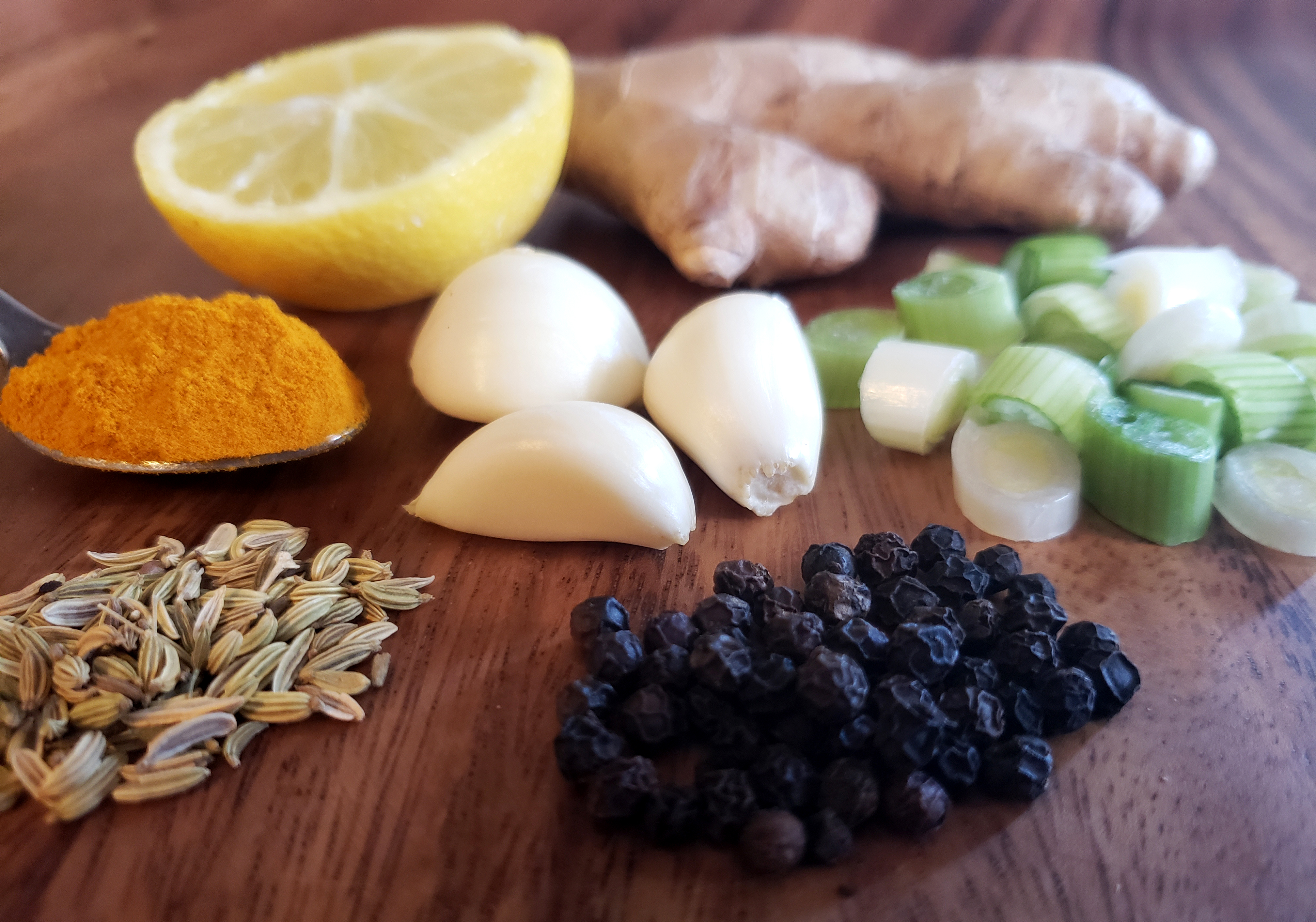
Ingredients
- 1 teaspoon ghee, coconut oil, or sesame oil
- 2 to 3 cloves of garlic, finely minced
- 1/4 teaspoon cumin seed, whole
- 1/4 teaspoon fennel seed, whole
- 1/4 teaspoon brown mustard seed, whole
- Large pinch of cayenne pepper (optional but recommended)
- 1/8 teaspoon freshly ground black pepper (or about 10-15 black peppercorns)
- 5 cups bone broth, chicken broth, or veggie broth (ideally homemade)
- 2 cups of water
- 1/4 cup mung dal (substitute with red lentils)—soak overnight and discard the liquid (optional but recommended)
- 1/2 cup basmati rice—soak or rinse in warm water to remove excess starch (optional but recommended)
- 1/2 teaspoon Agni Churna or turmeric powder*
- Fresh ginger (2-inch cube), grated or finely minced (substitute with 3/4 teaspoon dry ginger)
- 1/4 teaspoon pink Himalayan salt
- 1/2 lemon, juiced
- 2 green onions, chopped
Click here for a printable copy of this recipe.
Directions
1. Place the medium saucepan over medium heat and add in the ghee or oil. Once hot, add in the minced garlic, cumin seed, brown mustard seed, fennel seed, cayenne pepper (if used), and black pepper. Stirring constantly, sauté these spices for 2 minutes until the spices become slightly roasted and the garlic begins to turn a light brown.
2. Add in the broth and water. Turn the heat to high and bring to a boil.
3. Once boiling, turn the heat to low and add in the mung dal and basmati rice. Cover the pot, leaving a slight crack to avoid overflow.
4. Cook over low heat for 40 to 45 minutes. The final result should be a liquidy and well-cooked soup-like meal. The dal and rice should be split open and very soft to the touch.
5. Turn the heat off but leave the pan on the hot burner. Add in the turmeric, ginger, salt, lemon juice, and green onions. Stir well until everything is evenly blended.
6. Take a small serving for a healing breakfast, lunch, or dinner during times of cold, fever, flu, weakness, or general debility. For more severe illnesses, this should be the only meal until the hunger returns, the digestion is strengthened and optimal health is established.
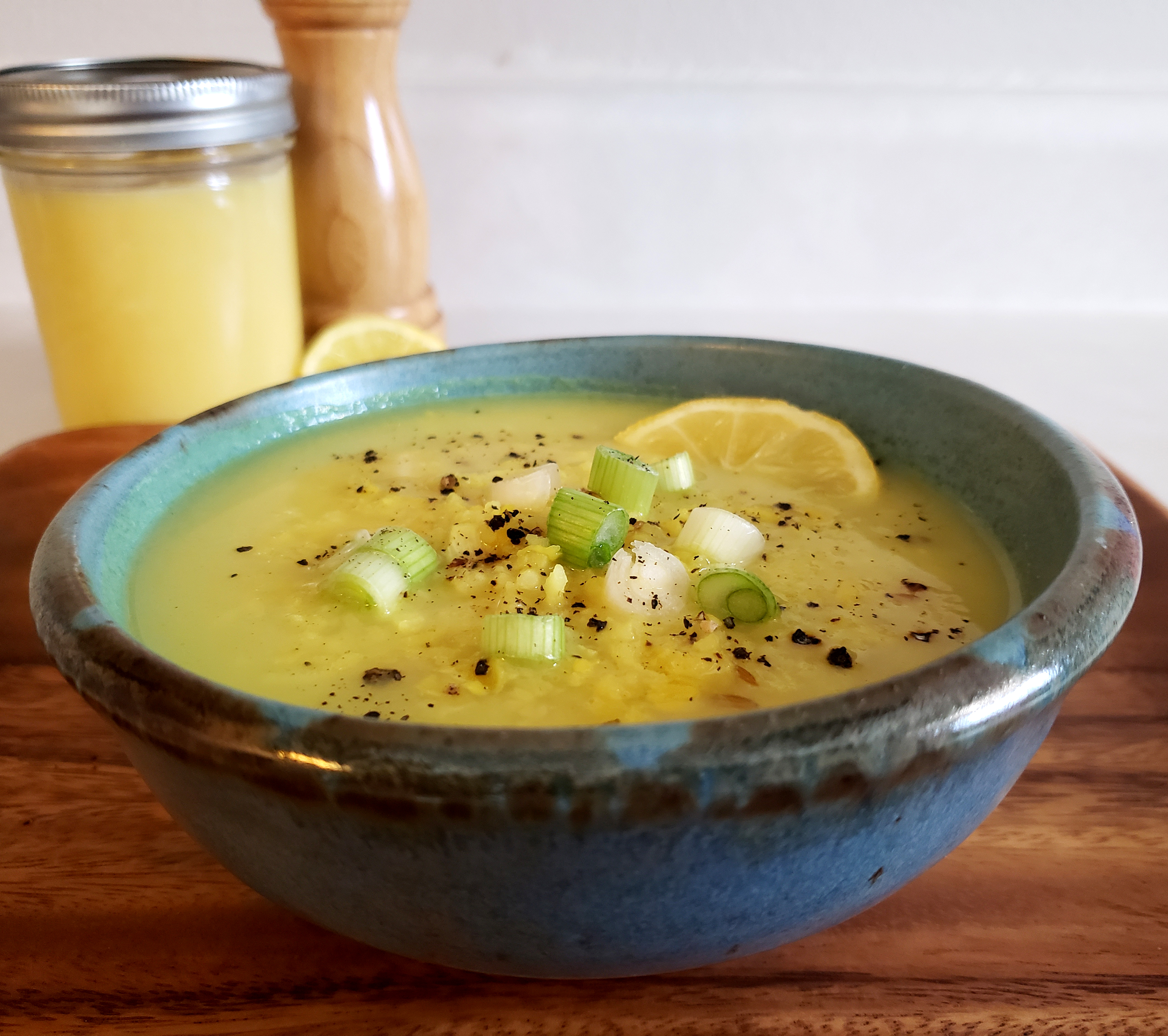
Additional Tips
- As the digestion slowly comes back, you can begin to add in some simple, cleansing vegetables such as celery, kale, broccoli, zucchini, or cauliflower. Please add these at the same time as the dal and rice, making sure they are well-cooked and mushy for the finished meal.
- As the digestion comes back to life and the hunger returns, you can double the amount of mung dal to add in a bit more strengthening nutrients.
- The spice amounts are a general recommendation, but extra ginger, black pepper, and turmeric can be added for more healing power!
- If basmati rice is not digested well (often true for Kapha-types) you can replace this grain with the same amount of white quinoa. The cooking time should remain the same, as long as the quinoa is mushy for the final meal. Cook longer if needed.
- For additional treatment during sickness, you should sip on Tulsi Synergy Spice Tea or Tulsi, Turmeric, and Ginger Tea between meals.
Continue Reading
-
7 Ayurvedic Remedies for Fighting the Cold and Flu (that really work!)
-
9 Simple Ways to Prevent a Cold
-
Kitchari: The What, Why, and How of an Ayurvedic Staple
Purchase all of your Kitchari essentials here!
Try our Tulsi Synergy Spice Tea!
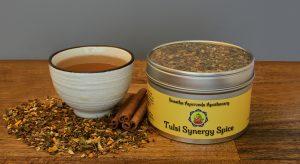
Discover more healing recipes with my 30-Minute Ayurvedic Cookbook!

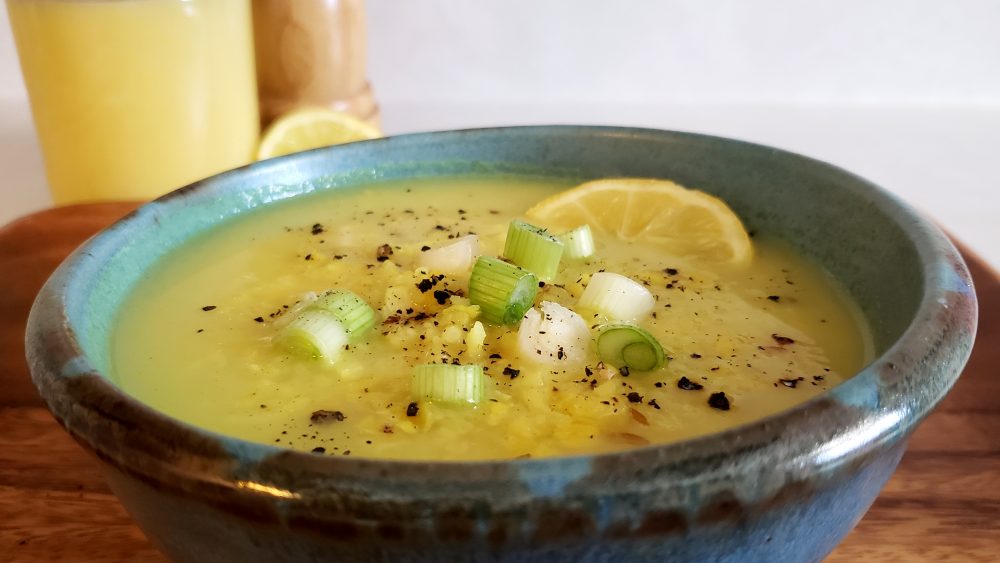

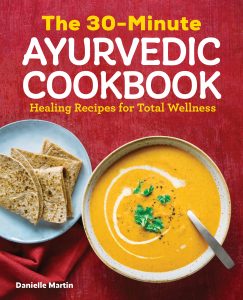

This is the yummiest and most delicious kitchari recipes I’ve made. Anytime I feel more tired, may be fighting something or want a little break from my normal diet I make this. It helped me get better a few weeks back and is now a staple in my weekly plans every other week.
Hi Danielle, thanks for the recipe. I thought any dhal and or rice should be soaked before cooking to reduce phytic acid. Isn’t it relevant in this process? Thanks for your input.
Hi Sulo,
Thank you for your question! Yes, I always soak my dal (or any legume) in water before cooking to help with digestibility and absorbency. You can soak or rinse the rice in warm water as well to remove the excess starch. It is not mentioned in this article, but I will add it in as an option for anyone who has the time to do so.
Thank you for taking the time to write in! I hope you enjoy the recipe:)
Namaste,
Danielle